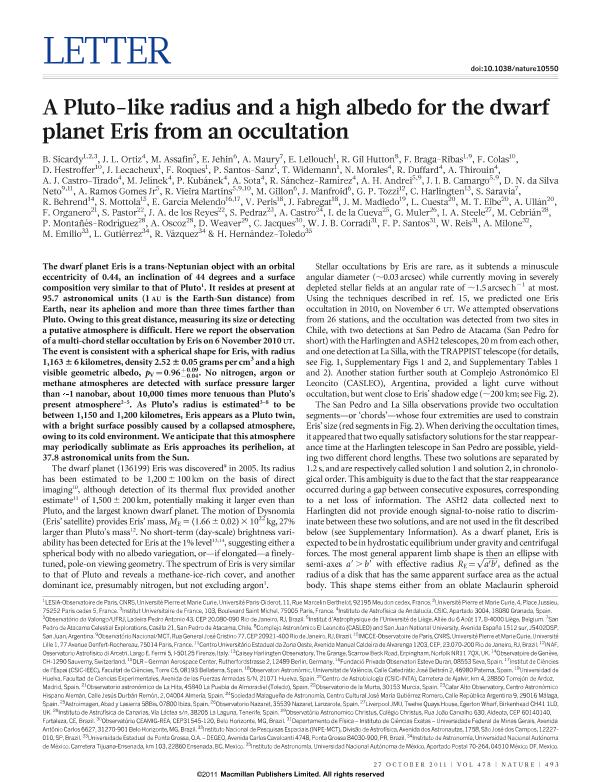Artículo
A Pluto-like radius and a high albedo for the dwarf planet Eris from an occultation
Sicardy, B.; Ortiz, J.L.; Assafin, M.; Jehin, E.; Maury, A.; Lellouch, E.; Gil Hutton, Ricardo Alfredo ; Braga Ribas, F.; Colas, F.; Hestroffer, D.; Lecacheux, J.; Roques, F.; Santos-Sanz, P.; Widemann, T.; Morales, N.; Duffard, R.; Thirouin, A.; Castro-Tirado, A.J.; Jelínek, M.; Kubánek, P.; Sota, A.; Sánchez-Ramírez, R.; Andrei, A.H.; Camargo, J.I.B.; Da Silva Neto, D.N.; Gomes Jr., A. Ramos; Martins, R. Vieira; Gillon, M.; Manfroid, J.; Tozzi, G.P.; Harlingten, C.; Saravia, S.; Behrend, R.; Mottola, S.; Melendo, E. García; Peris, V.; Fabregat, J.; Madiedo, J.M.; Cuesta, L.; Eibe, M.T.; Ullán, A.; Organero, F.; Pastor, S.; De Los Reyes, J.A.; Pedraz, S.; Castro, A.; De La Cueva, I.; Muler, G.; Steele, I.A.; Cebrián, M.; Montañés-Rodríguez, P.; Oscoz, A.; Weaver, D.; Jacques, C.; Corradi, W.J.B.; Santos, F.P.; Reis, W.; Milone, A.; Emilio, M.; Gutiérrez, L.; Vázquez, R.; Hernández Toledo, H.
; Braga Ribas, F.; Colas, F.; Hestroffer, D.; Lecacheux, J.; Roques, F.; Santos-Sanz, P.; Widemann, T.; Morales, N.; Duffard, R.; Thirouin, A.; Castro-Tirado, A.J.; Jelínek, M.; Kubánek, P.; Sota, A.; Sánchez-Ramírez, R.; Andrei, A.H.; Camargo, J.I.B.; Da Silva Neto, D.N.; Gomes Jr., A. Ramos; Martins, R. Vieira; Gillon, M.; Manfroid, J.; Tozzi, G.P.; Harlingten, C.; Saravia, S.; Behrend, R.; Mottola, S.; Melendo, E. García; Peris, V.; Fabregat, J.; Madiedo, J.M.; Cuesta, L.; Eibe, M.T.; Ullán, A.; Organero, F.; Pastor, S.; De Los Reyes, J.A.; Pedraz, S.; Castro, A.; De La Cueva, I.; Muler, G.; Steele, I.A.; Cebrián, M.; Montañés-Rodríguez, P.; Oscoz, A.; Weaver, D.; Jacques, C.; Corradi, W.J.B.; Santos, F.P.; Reis, W.; Milone, A.; Emilio, M.; Gutiérrez, L.; Vázquez, R.; Hernández Toledo, H.
 ; Braga Ribas, F.; Colas, F.; Hestroffer, D.; Lecacheux, J.; Roques, F.; Santos-Sanz, P.; Widemann, T.; Morales, N.; Duffard, R.; Thirouin, A.; Castro-Tirado, A.J.; Jelínek, M.; Kubánek, P.; Sota, A.; Sánchez-Ramírez, R.; Andrei, A.H.; Camargo, J.I.B.; Da Silva Neto, D.N.; Gomes Jr., A. Ramos; Martins, R. Vieira; Gillon, M.; Manfroid, J.; Tozzi, G.P.; Harlingten, C.; Saravia, S.; Behrend, R.; Mottola, S.; Melendo, E. García; Peris, V.; Fabregat, J.; Madiedo, J.M.; Cuesta, L.; Eibe, M.T.; Ullán, A.; Organero, F.; Pastor, S.; De Los Reyes, J.A.; Pedraz, S.; Castro, A.; De La Cueva, I.; Muler, G.; Steele, I.A.; Cebrián, M.; Montañés-Rodríguez, P.; Oscoz, A.; Weaver, D.; Jacques, C.; Corradi, W.J.B.; Santos, F.P.; Reis, W.; Milone, A.; Emilio, M.; Gutiérrez, L.; Vázquez, R.; Hernández Toledo, H.
; Braga Ribas, F.; Colas, F.; Hestroffer, D.; Lecacheux, J.; Roques, F.; Santos-Sanz, P.; Widemann, T.; Morales, N.; Duffard, R.; Thirouin, A.; Castro-Tirado, A.J.; Jelínek, M.; Kubánek, P.; Sota, A.; Sánchez-Ramírez, R.; Andrei, A.H.; Camargo, J.I.B.; Da Silva Neto, D.N.; Gomes Jr., A. Ramos; Martins, R. Vieira; Gillon, M.; Manfroid, J.; Tozzi, G.P.; Harlingten, C.; Saravia, S.; Behrend, R.; Mottola, S.; Melendo, E. García; Peris, V.; Fabregat, J.; Madiedo, J.M.; Cuesta, L.; Eibe, M.T.; Ullán, A.; Organero, F.; Pastor, S.; De Los Reyes, J.A.; Pedraz, S.; Castro, A.; De La Cueva, I.; Muler, G.; Steele, I.A.; Cebrián, M.; Montañés-Rodríguez, P.; Oscoz, A.; Weaver, D.; Jacques, C.; Corradi, W.J.B.; Santos, F.P.; Reis, W.; Milone, A.; Emilio, M.; Gutiérrez, L.; Vázquez, R.; Hernández Toledo, H.
Fecha de publicación:
10/2011
Editorial:
Nature Publishing Group
Revista:
Nature
ISSN:
0028-0836
Idioma:
Inglés
Tipo de recurso:
Artículo publicado
Clasificación temática:
Resumen
The dwarf planet Eris is a trans-Neptunian object with an orbital eccentricity of 0.44, an inclination of 44 degrees and a surface composition very similar to that of Pluto. It resides at present at 95.7 astronomical units (1ĝ€‰au is the Earth-Sun distance) from Earth, near its aphelion and more than three times farther than Pluto. Owing to this great distance, measuring its size or detecting a putative atmosphere is difficult. Here we report the observation of a multi-chord stellar occultation by Eris on 6 November 2010 ut. The event is consistent with a spherical shape for Eris, with radius 1,163±6 kilometres, density 2.52±0.05 grams per cm 3 and a high visible geometric albedo,. No nitrogen, argon or methane atmospheres are detected with surface pressure larger than about 10,000 times more tenuous than Pluto's present atmosphere. As Pluto's radius is estimated to be between 1,150 and 1,200 kilometres, Eris appears as a Pluto twin, with a bright surface possibly caused by a collapsed atmosphere, owing to its cold environment. We anticipate that this atmosphere may periodically sublimate as Eris approaches its perihelion, at 37.8 astronomical units from the Sun. © 2011 Macmillan Publishers Limited. All rights reserved.
Palabras clave:
No Utilizado
Archivos asociados
Licencia
Identificadores
Colecciones
Articulos(CASLEO)
Articulos de COMPLEJO ASTRONOMICO "EL LEONCITO"
Articulos de COMPLEJO ASTRONOMICO "EL LEONCITO"
Citación
Sicardy, B.; Ortiz, J.L.; Assafin, M.; Jehin, E.; Maury, A.; et al.; A Pluto-like radius and a high albedo for the dwarf planet Eris from an occultation; Nature Publishing Group; Nature; 478; 7370; 10-2011; 493-496
Compartir
Altmétricas



